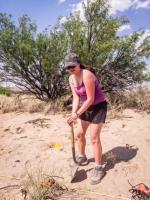Siena Sage Collier

Siena Sage Collier is a student at UNC Chapel Hill currently completing her research at Louisiana State University under Dr. Juan Lorenzo.
This project will demonstrate how angularity of sand grains affects the p-wave and s-wave velocity versus how they are in round grains. In previous studies, sand grains are modeled as spheres and predictions are made about how the degree of roundness changes the p and s wave velocity. This project will also examine how water saturation will change the velocity of seismic waves and the degree of so based on porosity.
Week 3
July 13th, 2018
I found the elevator speech assignment to be very challenging since I am constrained to only 60 seconds. I feel that I can explain and describe my research project well, but I am struggling to do so in such a short amount of time. It would be easier to do this if I was giving this speech to only geophysicists who would know what I am talking about when I refer to terminalogy and different pieces of equipment. I think that I can indeed construct a 60 second elevator speech for AGU since I will not have to explain everything and can just talk about my project. However, I do not think that this short speech will be very useful outside of AGU except for graduate school advisors and professors. I do believe that being able to construct a short speech to summarize my research will be useful at future conferences or graduate school interviews, but I do not feel that 60 seconds is enough time for presenting to someone who is not familiar with the subject matter.
Week 2: Data and its Utilization Techniques
June 26th, 2018
This summer, I will be working with data that I collect in the lab using a piezolectric actuator and transducer, amplifier, pulser, accelerometer (small geophone), and an oscilloscope. I will use the oscilloscope and pulser to measure the rise time of the pulse first without the geophone or any additional material. Next, I will use the accelerometer with the amplifier in the oscilloscope in addition to the actuator to measure the arrival time of the pulse through different materials (acrylic, wood) of different lengths in order to calibrate the oscilloscope and find the y-intercept of the time distance plot before making measurements in the sandtank.
The strengths of data I am using are that I will get several measurements to calibrate the oscilloscope before collecting data for experiment and should get precise measurements with similar error if the same time divide is used. One weakness is that the arrival time is measured manually on the oscilloscope and it will be slightly different with different time divides even with same material and thickness. I am starting with my own data in order to calibrate oscilloscope, but some data for the actual sand tank project has already been collected, and the project was started by a previous student.
One skill from the rubric which I want to conquer this summer is learning how to use software and statistics for data analysis and presentation in graphical form. I will use matlab in order to accomplish this task. Demonstrating this skill proficiently would mean that I could use matlab or other data analysis software to analyze and utilize data to create plots and figures to use and be able to explain during my poster presentation at AGU.
It is important for me to develope this skill in order to do further research at my university to complete an honor's thesis and to succeed in incorporating data for my thesis in graduate school. In order to further develope this skill, I have completed several matlab tutorials and spent a good bit of time applying the learned code and skills from the tutorial to create my own coding examples and functions. Additionally, I am writing down each error I make in a Matlab don't document so I remember not to make that same mistake in the future. Since matlab is case and space sensitive, there are several small mistakes one can make unknowingly, so having a list of commands and dont's is very helpful and will help me with coding for my project after I collect data, and for further applications in my future.
Week 1
June 18th, 2018
My name is Siena Sage Collier and I am a rising senior at UNC Chapel Hill majoring in geology. Through this summer, I would like to create models for seismic wave velocities through angular sand grains and demonstrate this tenique in the sand take in the seismology lab at LSU. In order to accomplish my goal, I will first need to learn how to program and model equations for simpler (spherical) grain models understand how water saturated changes bulk and shear modulus of the waves which in turn affect the velocities of p and s waves and read several articles based on previous studies. Next, I will need to collect data for the angular sand grain seismic velocities using seismic instruments and the sandtank in the lab. Finally, I will have to use derived equations and fit the seismic velocities to these models. I will then have to formulate my findings into a presentable poster and submit an abstract.


